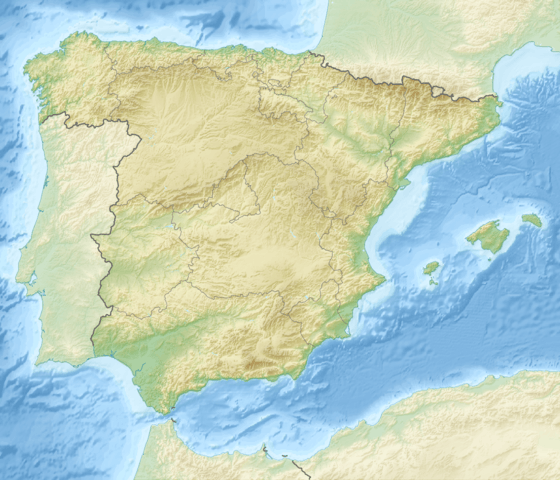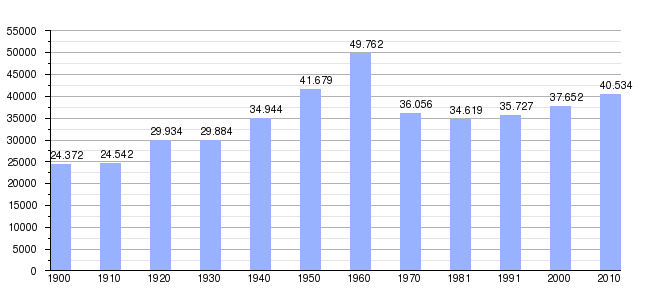Écija
Écija (Spanish pronunciation: [ˈeθixa]) is a town and municipality of Spain belonging to the province of Seville, Spain, in the autonomous community of Andalusia. It is in the countryside, 85 km east of the city of Seville. According to the 2008 census, Écija has a total population of 40,100 inhabitants, ranking as the fifth most populous municipality in the province. The river Genil, the main tributary of the river Guadalquivir, runs through the city.
Écija | |
|---|---|
 | |
.svg.png) Flag  Coat of arms | |
 Écija Location in Andalusia  Écija Écija (Andalusia) | |
| Coordinates: 37°32′N 5°5′W | |
| Country | Spain |
| Autonomous community | Andalusia |
| Province | Seville |
| Government | |
| • Mayor | David Javier García Ostos (2015-) (PSOE) |
| Area | |
| • Total | 978.73 km2 (377.89 sq mi) |
| Population (2018)[1] | |
| • Total | 39,882 |
| • Density | 41/km2 (110/sq mi) |
| Time zone | UTC+1 (CET) |
| • Summer (DST) | UTC+2 (CEST) |
| Postal code | 41400 |
| Official language(s) | Spanish |
| Website | Official website |
The economy of Écija is based on agriculture (olives, cereals and vegetables), cattle (cows and horses) and textile industry. The city has over twenty churches and convents, some of them with either Gothic, Mudéjar, Renaissance or Baroque towers or bell-gables, as well as an Arab fortress.
In the Philippines, the province of Nueva Ecija that was created as a military comandancia in 1705 by Governor Fausto Cruzat y Góngora, was named in honour of this city.
History
Roman Astigi
Ancient Iberian finds date back to the 8th century BC, and there are several archaeological remains of later Greek and Roman settlements. In Roman times the town was at first known as Astigi. During the Roman civil war Écija stood "firmly" at the side of Julius Caesar in the Battle of Munda. As a reward Caesar ordered the town's fortification and refounded it as a Julian colony, possibly Colonia Iulia Firma Astigitana. Under the reign of Octavian, the later emperor Augustus, the colony was strengthened according to Caesar's construction plans, and its name was finalised as Colonia Iulia Augusta Firma Astigitana.[2] According to Pliny the Elder and Pomponius Mela, who both wrote in the 1st century AD, it was the rival of Cordova and Seville.[3]
Astigi was an important town of Hispania Baetica, as well as the seat of the Astigitanus, one of the four conventi where the chief men met together at fixed times of the year under the eye of the proconsul to oversee the administration of justice. It was also from an early date the seat of a diocese. St. Fulgentius (died before 633), was named to the see by his brother Isidore of Seville. With the Reconquista, by which areas that had been held by Muslims were restored to Christian hands, the archdiocese of Seville was recovered, leading to the overshadowing of nearby Astigi, whose territory was joined to that of the archdiocese in 1144. Astigi thus ceased to be a residential diocese and is today listed by the Catholic Church as a titular see.[4]
Post-Roman
After the Romans, it was ruled by successively by Suevs and Visigoths before the Umayyad conquest in 711. Arabs renamed Astigi as "Istija" (إستجة), from which the present name is derived. It was under Arab rule until its conquest in 1240 by Fernando III, King of Castile.
Although Astigi was one of the largest and most complete Roman cities ever unearthed, mayor Julian Álvarez Pernía decided in 1998 to bulldoze Écija's Roman ruins and replace them with a 299-car parking lot.[5]

Climate
Écija is known in Spain as La sartén de Andalucía ("The Frying Pan of Andalusia"),[3] supposedly because its high summer temperatures, although records show higher temperatures elsewhere in Spain (Murcia or Montoro, Córdoba).
Écija suffered several floods in December 2010.[6]
Population
| Development of the Écija population since 1900[7] |
|---|
 |
Landmarks
- Convento de la Santísima Trinidad y Purísima Concepción
- Real Monasterio de Santa Inés del Valle
- Church of Santa María
- St. James' Church
- Holy Cross Church
- St John the Baptist's Church
- Peñaflor House
- Benamejí Palace
- Vallehermoso House
References
- Municipal Register of Spain 2018. National Statistics Institute.
- Macfarquhar, Colin; Gleig, George (1797). Encyclopædia britannica: or, A dictionary of arts, sciences, and miscellaneous literature. A. Bell and C. Macfarquhar. p. 46. Retrieved 27 January 2013.
-

- Annuario Pontificio 2013 (Libreria Editrice Vaticana 2013 ISBN 978-88-209-9070-1), p. 841
- Clarke, Jon. "Spain destroys lost Roman city for a car park". Times Online. Retrieved 27 January 2013.
- "Écija cuantifica los daños causados por las inundaciones en 23,5 millones" (in Spanish). Europress. Retrieved 27 January 2013.
- "Población de municipios españoles. Serie histórica" (in Spanish). Instituto Nacional de Estadística. Retrieved 2014-05-21.
External links
| Wikimedia Commons has media related to Écija. |
- Turismo Écija, in English.
- EcijaWeb, in Spanish.
- Astigi Romana
- Bishops of Astigi: list
- Catholic Hierarchy: Astigi (titular see)